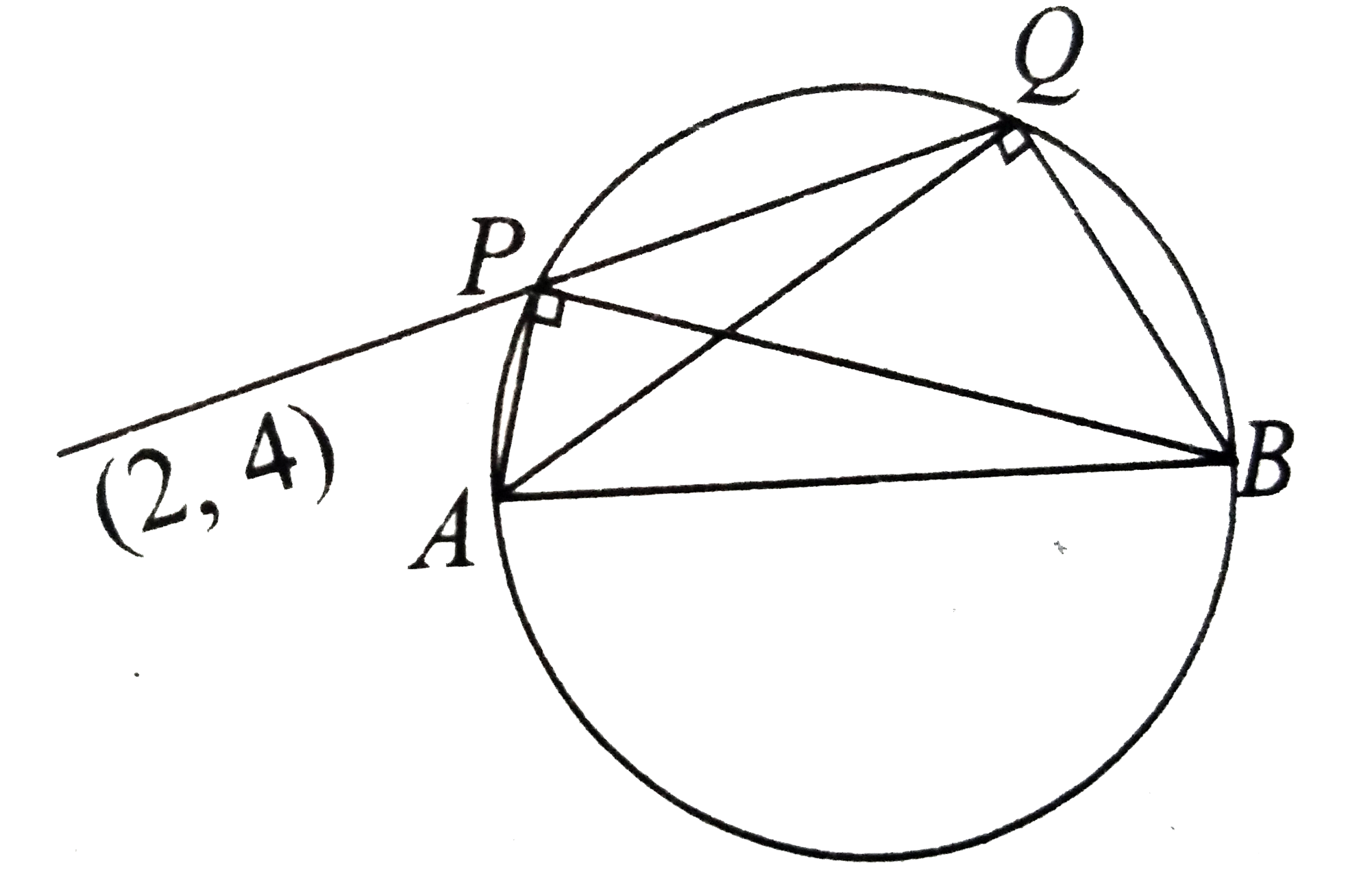P and Q are two points on a line passing through (2, 4) and having slope m. If a line segment AB subtends a right angles at P and Q, where A(0, 0) and B(6,0), then range of values of m isSolution in Bengali
A. (2−3√24,2+3√24)
B. (−∞,2−3√24)∪(2+3√24,∞)
C. (−4,4)
D. (−∞,−4)∪(4,∞)
The correct Answer is:B
AB subtends right angle at P and Q on variable line.

So, AB is a diameter of circle whose chord is a variable line. Equation of circle is:
x(x−6)+y×y=0
or x2+y2−6x=0 (i)
Equation of line through (2,4) is:
y−4=m(x−2)
or y=mx+(4−2m) (ii)
Line (ii) is a chord if ∣∣∣3m+(4−2m)√1+m2∣∣∣<3
⇒8m2−8m−7>0
m∈(−∞,2−3√24)∪(2+3√24,∞)
Topper's Solved these Questions
- BOOK - CENGAGE PUBLICATIONCHAPTER - CIRCLESEXERCISE - Multiple Correct Answers Type9videos
CIRCLES
- BOOK - CENGAGE PUBLICATIONCHAPTER - CIRCLESEXERCISE - Comprehension Type8videos
CIRCLES
- BOOK - CENGAGE PUBLICATIONCHAPTER - CIRCLE EXERCISE - For problems 3 and 42videos
CIRCLE
- BOOK - CENGAGE PUBLICATIONCHAPTER - COMPLEX NUMBERSEXERCISE - MULTIPLE CORRECT ANSWER TYPE6videos
COMPLEX NUMBERS
Similar Questions
The line 3x+6y=k intersects the curve 2x2+3y2=1 at points AandB . The circle on AB as diameter passes through the origin. Then the value of k2 is__________
02:08View Solution
In the diagram as shown, a circle is drawn with centre C(1,1) and radius 1 and a line L. The line L is tangent to the circle at Q. Further L meets the y-axis at R and the x-axis at P in such a way that the angle OPQ equals θ where 0<θ<π2.
Coordinate of Q is03:58View SolutionPARAGRAPH X Let S be the circle in the xy -plane defined by the equation x2+y2=4. (For Ques. No 15 and 16) Let E1E2 and F1F2 be the chords of S passing through the point P0(1, 1) and parallel to the x-axis and the y-axis, respectively. Let G1G2 be the chord of S passing through P0 and having slope −1 . Let the tangents to S at E1 and E2 meet at E3 , the tangents to S at F1 and F2 meet at F3 , and the tangents to S at G1 and G2 meet at G3 . Then, the points E3, F3 and G3 lie on the curve x+y=4 (b) (x−4)2+(y−4)2=16 (c) (x−4)(y−4)=4 (d) xy=4
05:31View SolutionLet z1 and z2 be two distinct complex numbers and z=(1−t)z1+tz2, for some real number t with 0<t<1 and i=√−1. If arg(w) denotes the principal argument of a non-zero compolex number w, then
View SolutionFind the slope of a line, which passes through the origin, and the midpoint of the line segment joining the points P(0,4)and B(8,0).
01:28View SolutionLet A≡(−1,0),B≡(3,0), and PQ be any line passing through (4, 1) having slope m. Find the range of m for which there exist two points on PQ at which AB subtends a right angle.
02:03View SolutionP and Q are two points on a line passing through (2,4) and having slope m.If a line segment AB subtends a right angles at P and Q,where A(0,0) and B(6,0), then range of values of m is
01:34View SolutionFind the slope of a line, which passes through the origin, and the mid-point of the line segment joining the points P(0,−4) and B(8,0).
01:34View SolutionThe slope of line passing through the points P(−3,5) and Q(4,−1) is
05:11View SolutionGraph the line passing through the point P and having slope m. P=(-1,3),m=0
05:22View SolutionFind the slope of a line, which passes through the origin, and the mid-point of the line segment joining the points P(0, -4) and B(8, 0).
04:13View SolutionFind the slope of a line, which passes through the origin, and the mid-point of the line segment joining the points P(0, -4) and B(8, 0).
02:53View SolutionLet A=(−1,0),B=(3,0) and PQ be any line passing through (4, 1) having slope m. Find the range of m for which there exist two points on PQ at which AB subtends a right angle.
03:43View SolutionP and Q are two points on a line passing through (2, 4) and having slope m. If a line segment AB subtends a right angles at P and Q, where A(0, 0) and B(6,0), then range of values of m is
02:17View SolutionLet A≡(−1,0),B≡(3,0), and PQ be any line passing through (4, 1) having slope m. Find the range of m for which there exist two points on PQ at which AB subtends a right angle.
01:07View SolutionFind the slope of a line, which passes through the origin, and the mid-point of the line segment joining the points P(0,−4)andB(8,0).
04:15View Solution

